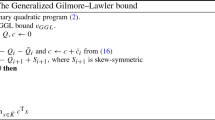Abstract
Many polynomial and discrete optimization problems can be reduced to multiextremal quadratic type models of nonlinear programming. For solving these problems one may use Lagrangian bounds in combination with branch and bound techniques. The Lagrangian bounds may be improved for some important examples by adding in a model the so-called superfluous quadratic constraints which modify Lagrangian bounds. Problems of finding Lagrangian bounds as a rule can be reduced to minimization of nonsmooth convex functions and may be successively solved by modern methods of nondifferentiable optimization. This approach is illustrated by examples of solving polynomial-type problems and some discrete optimization problems on graphs.
Similar content being viewed by others
References
Alizadeh, F. (1995), Interior point methods in semidefinite programming with applications to combinatorial optimization. SIAM Journal on Optimization 5, 13–51.
Anjos, M.F. and Wolkowicz, H. A strengthened SDP relaxation via second lifting for the maxcut problem, University ofWaterloo, Department of Combinatorics and Optimization, Research Report CORR 99-55, 28 pp.
Barahona, F., Grötshel, M. and Mahjoub, A. (1985), Facets of the bipartite subgraph polytope Mathematics of Operations Research10, 340–358.
Barahona, F. and Mahjoub, A. (1986), On the cut polytope. Mathematics Programming, 36, 157–173.
Berge, C. (1961), Farbung von Graphen, deren samtiche bzv. deren ungerade Kreise starr sind (Zusammenfassung), Wissenschaftliche Zeitschrift, Martin Luther Universitat Halle-Wittenberg, Mathematisch-Naturwissenschaftliche Reihe, pp. 114–115.
Berge, C. (1962), Sur une conjecture relative au probleme des codes optimaux, Communication, 13eme assemblee generake de l'URSI, Tokyo.
Bertsekas, D.P. (1995), Nonlinear Programming, Athena Scientific, Belmont, Massachusetts, P. 646.
Cox, S.J. (1992), The shape of the ideal column, Mathematical Intelligencer 14, 16–31.
Cullum, J. Donath, W.E. and Wolfe, P. (1975), The minimization of certain nondifferentiable sums of eigenvalues of symmetric matrices, Mathematical Programming Study 3, 35–55.
Delorme, C. and Poljak, S. (1993), Laplacian eigenvalues and the maximum cut problem, Math. Programming 62(3), 557–574.
Demyanov, V.F. and Rubinov, A.M. (1980), On quasidifferentiable functionals, Soviet Mathematics Doklady 21, 14–17
Dikin, I.I. and Zorkaltsev, V.I. (1980), Iterative solving of mathematical programming problem (interior point method: algoritms), Nauka, Moscow, (in Russian).
Donath, W.E. and Hoffman, A.J. (1972), Algorithm for partitioning graphs and computer logic based on eigenvectors of connection matrices, Math. Prog. Study 3, 35–55.
Donath, W.E. and Hoffman, A.J. (1973), Lower bounds for the partitioning of graphs, IBM J. Res. Dev. 17.
Frieze, A. and Jerum, M. 1995, Improved approximation algorithms for max k-cut and max bisection, Reprint, Carnegi Mellon University, pp. 1-17.
Goemans, M.X. 1997, Semidefinite programming in combinatorial optimization, Math. Programming 79, 143–162.
Fan, K. (1949), On a theorem of Weyl concerning the eigenvalues of linear transformations, Proceedings of the National Academy of the Sciences of U.S.A.35, 652–655.
Goemans, M.X. and Williamson, D.P. (1994), 0.878-Approximation algorithms forMAX-CUT and MAX 2SAT, Proceedings of the 26th Annual ACM Symposium on Theory of Computing, 422–431.
Grötshel, M. and Pulleyblank, W. (1981), Weakly bipartite graphs and the max-cut problem. Operations Research letters1, 23–27.
Grötschel, M., Lóvasz, L. and Schrijver, A. (1988), Geometric Algotithms and Combinatorial Optimization, Vol. 2 Combinatorics. Springer, Berlin.
Hilbert, D., Ñber die Darstellung definiter Formen als Summen von Formen quadraten. Math. Ann. Leipzig, 1888, Bd. 22, pp. 342–350.
Lawrent, M., Poljak, S. and Rendl, F. (1997), Connections between the semidefinite relaxations of the max-cut and stable set problems, Math. Programming 77, 225–246.
Lewis, A.S. and Overton, M.L. (1996), Eigenvalue Optimization, Acta Numerica 5, 149–190.
Lóvasz, L. (1979), On the Shannon-capacity of graph. IEEE Transactions on information theory. IT-25 1, 1–7.
Lóvasz, L. (1972), Normal hypergraphs and the perfect graph conjecture, DiscreteMathematics 2, 253–267.
McElice, R., Rodemich, E. and Romsey, Jr. H. (1978), The Lovash bound and some generalization. Journal of combinatorics, Information and System Science. 3(3), 134–152.
Narasimhan, G. and Manber, R. (1990), A generalization of Lovasz's sandwich theorem, Polyhedral combinatorics: Proced. of a DIMACS Workshop AMS.
Nemirovsky, A. and Yudin, D.B. (1983), Problem Complexity and Methods Efficiency in Optimization, J. Wiley, New York.
Nesterov, Yu. and Nemirovskii, A. (1994), Interior point polynomial algorithm in convex programming, SIAM, p. 406.
Shannon, C. (1956), The zero-error capacity of a noisy channel. IRe Transactions Information Theory. IT 2, 8-19.
Shrijver, A. (1979), A comparison of the Delsarte and Lovash bounds. IEEE Transactions on Information Theory. IT-25, 4.
Shor, N.Z. (1970), Methods of non-differentiable optimization and its applications. Ph.D. Thesis,Institute of Cybernetics of NASU, Kiev, Ukraine.
Shor, N.Z. (1998), Nondifferentiable Optimization and Polynomial Problems, Kluwer, Dordrecht.
Shor, N.Z. and Berezovski, O.A. (1995). New algorithms for solving weight max-cut problem, Kibernetika i sistemny analiz2, 100–106.
Shor, N.Z. Stetsenko, S.I. (1989), Quadratic extremal problems and nondifferentiable optimization, Naukova dumka, Kiev, (in Russian).
Shor, N.Z. and Stetsyuk, P.I. (1997), Using of r-algorithm modifications for obtaining of global minimum of polynomial functions, Kibernetika i sistemny analiz 4, Kiev.
Yannakakis, M. (1978), Node and edge deletion NP-complete problems. Proc. 10th Ann. ACM Symp. on Theory of Computing. New York, pp. 253–264.
Author information
Authors and Affiliations
Rights and permissions
About this article
Cite this article
Shor, N.Z., Stetsyuk, P.I. Lagrangian bounds in multiextremal polynomial and discrete optimization problems. Journal of Global Optimization 23, 1–41 (2002). https://doi.org/10.1023/A:1014004625997
Issue Date:
DOI: https://doi.org/10.1023/A:1014004625997



